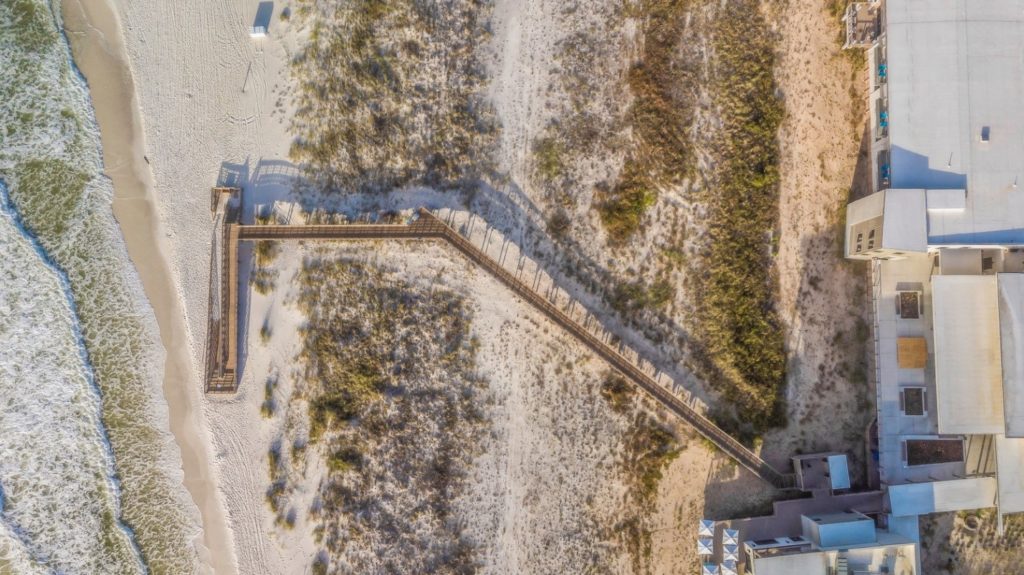Seventeen years ago, Hurricane Ivan destroyed Alabama’s Gulf State Park in Gulf Shores, including a waterfront lodge. With funding through Natural Resource Damage Assessment (NRDA) acquired due to the Deepwater Horizon oil spill, the Alabama Department of Conservation and Natural Resources (ADCNR) launched a $135 million enhancement program for Gulf State Park. The goal of the program was to restore the health and beauty of the park and the surrounding region through low-impact development of amenities that enhance the ecosystem, attract and educate visitors, and repair and restore economic and environmental damage from the oil spill.
The enhancement program included five primary components: a 350-room hotel and conference center, a sustainable off-grid interpretive center, an environmentally-friendly learning campus, a restored 28-mile trail system, and 50 acres of restored coastal dune habitat.
Volkert was proud to provide construction management and environmental permitting services for the program.
Fortifying Gulf State Park’s buildings
As part of a pilot project for the Insurance Institute for Business and Home Safety (IBHS), the rebuild process for the three new structures followed FORTIFIED Commercial™ construction standards. The Lodge at Gulf State Park is also a certified LEED Gold and SITES® Platinum property. Once completed, the Gulf State Park enhancement project became the first hospitality project in the world to achieve all three certifications.
“The roof is the most important element holding a structure together,” says Stan Winter, construction project manager for Volkert. “Using IBHS’s fortification recommendations, we built Gulf State Park’s lodge, interpretive center, and learning campus to withstand high-wind storms.”
Following more than 20 years of scientific research and real-world testing, IBHS developed a set of building guidelines and standards designed to provide additional protection from extreme weather events such as hurricane-force winds, rain, and hail. The standards, known as FORTIFIED, have proven to be an effective and cost-efficient method for preparing communities for natural disasters.
“It is IBHS’ goal to be a leader in building science research and help create more resilient communities,” says Chris Cioffi, commercial line engineer at IBHS. “While no structure is fully immune to nature’s most extreme weather, IBHS research continues to show that mitigation and strong building codes are the best ways to prepare communities for natural disasters.”
The IBHS Research Center is a state-of-the-art research facility in Chester County, South Carolina. This unique facility enables building science researchers to evaluate residential and commercial construction materials and systems under realistic recreations of severe weather hazards.
This facility is also a tangible, public demonstration of the property insurance industry’s deep commitment to reducing and preventing losses that disrupt the lives of millions of home and business owners each year.
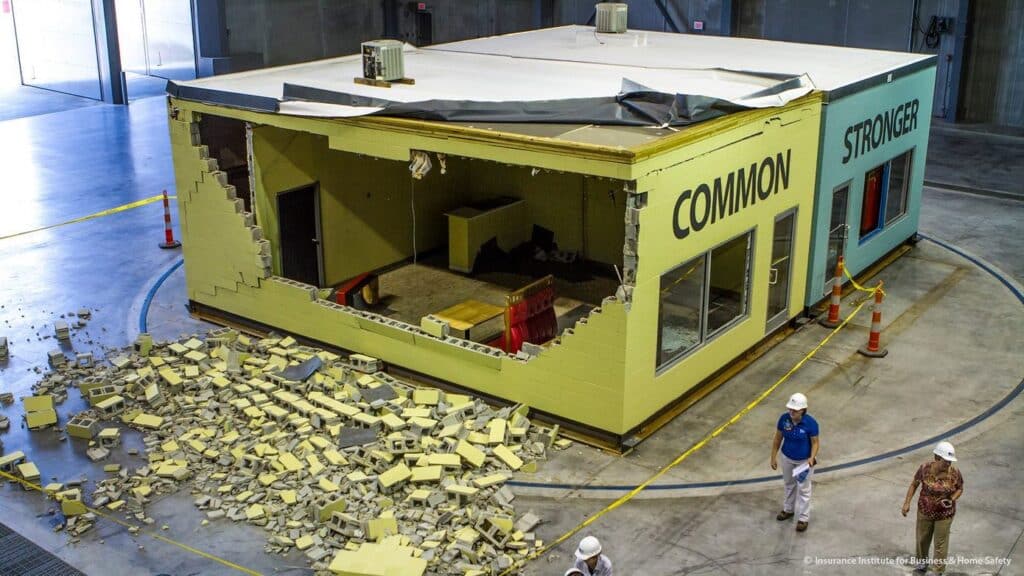
The IBHS Research Center tests common and FORTIFIED building codes under hurricane force winds for commercial buildings.
“During the Lodge’s roof construction, the contractor installed fasteners in perimeter corners that were closer together and in a particular pattern that goes above and beyond common commercial building practices,” says Winter.
As part of the FORTIFIED Commercial™ building process, IBHS officials regularly inspected the construction progress to verify that not only the right materials were being used, but that they were installed properly.
“We worked closely with Volkert and the project’s developers, as well as state and local leaders, on ensuring Gulf State Park’s new structures were built so they are more resilient from the risks of property damage caused by hurricanes and other wind-driven severe weather events,” says Cioffi. “The roof, the walls, the foundations, and the inspection process are what truly tie it all together to be certified as a FORTIFIED structure.”
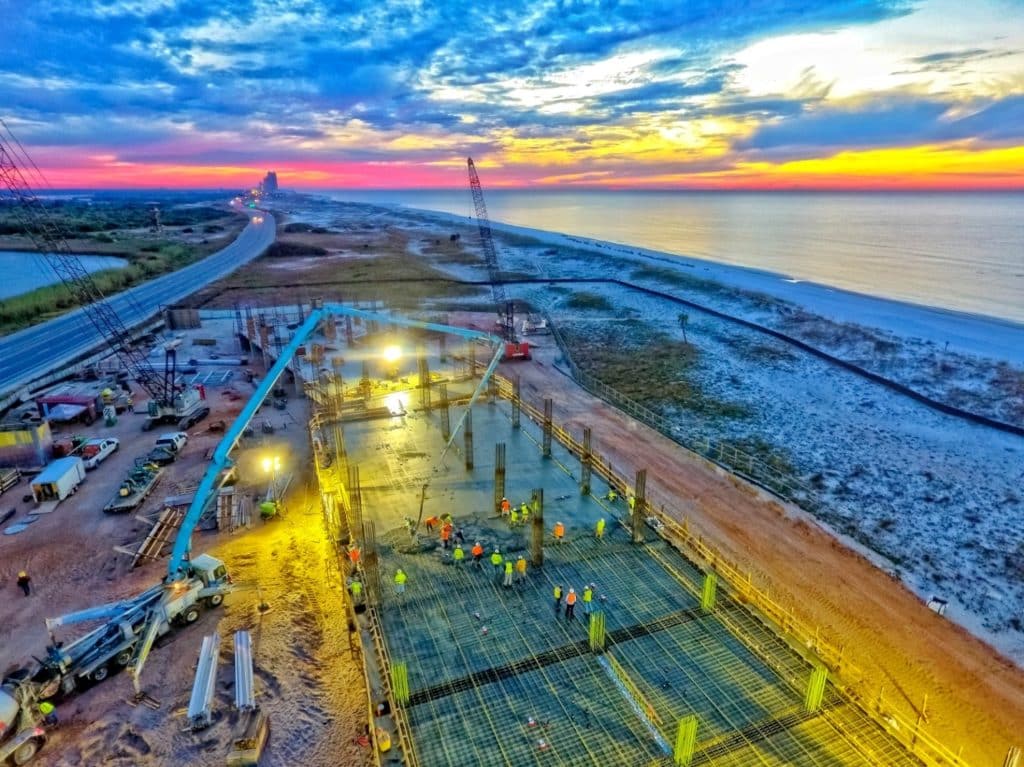
There were 751 reinforced concrete piles driven into the ground as part of the Lodge’s foundation system. At an average length of 61 feet each, that’s over 8 miles of piles. Water was used to assist the pile driving operation at the Lodge. Each concrete pile required over 2,000 gallons of jetted water to assist ground penetration. In total, over 1.5 million gallons of water were used to assist in driving the 751 piles, but not a single drop of it came from the municipal water supply.
Volkert’s construction managers worked with the contractors to develop a simple yet innovative process whereby groundwater discharged from the foundation dewatering system was recaptured and stored on site then used in the pile jetting and driving operation. This saved the client tens of thousands of dollars in utility costs over the course of the foundation phase.
Each structure was also built an extra three feet above the storm surge level for better protection.
Resilient through Hurricane Sally
In 2020—two years after construction was completed—Gulf State Park was tested by a direct hit from Hurricane Sally. Ironically, Hurricane Sally was the first hurricane to make landfall on the Alabama coast since Hurricane Ivan in 2004, exactly sixteen years apart to the day.
Sally made landfall on September 16, 2020, in Gulf Shores as a Category 2 storm with winds up to 105 miles per hour. Moving at only two miles per hour, Alabama’s coast was under the storm’s eye and most intense winds for hours.
Not only did The Lodge at Gulf State Park survive the storm with minimal damage, it served as a refuge for employees and their families during the storm and the weeks following.
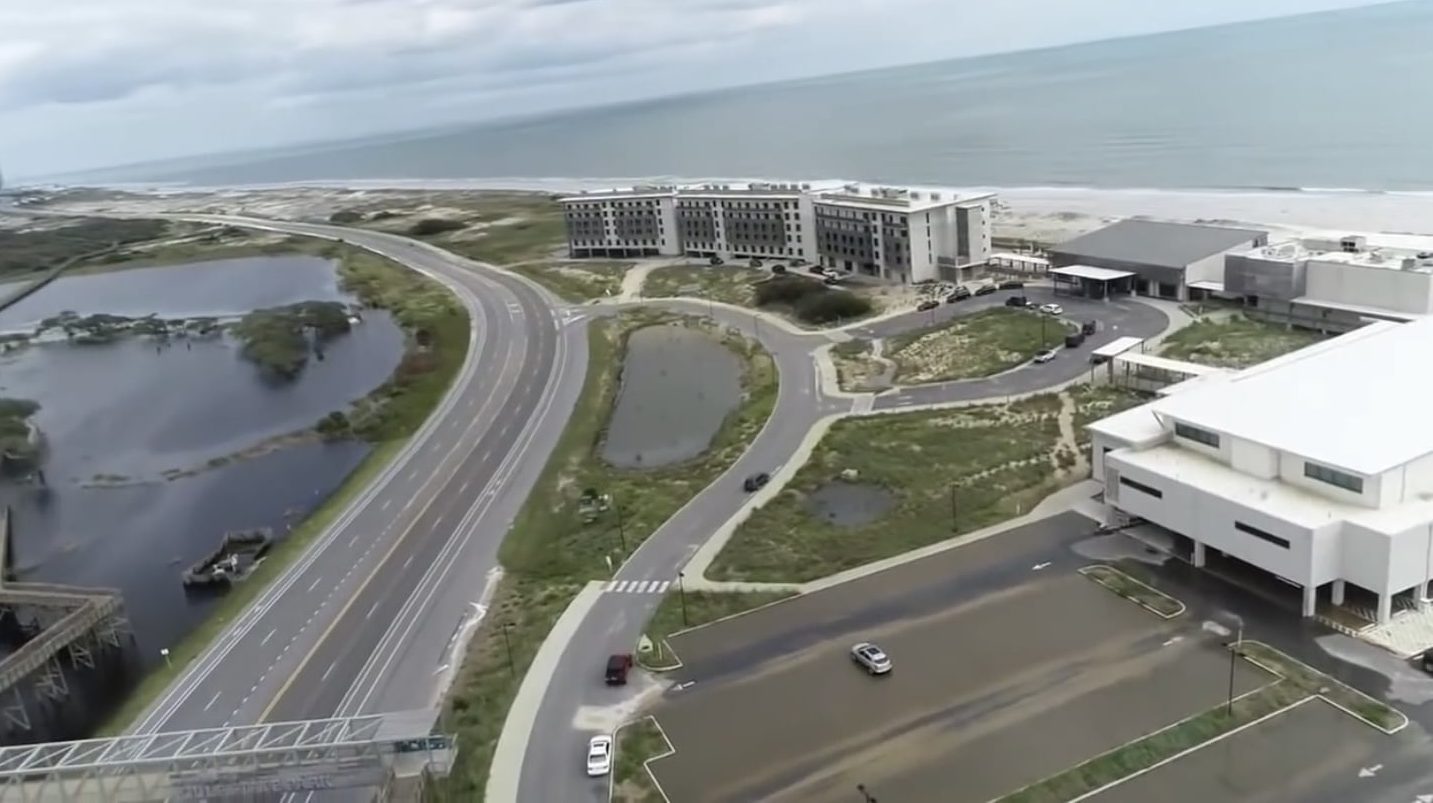
“We were able to safely accommodate 30 associates and their families that night, including me and my family,” says Bill Bennett, Valor Hospitality’s regional director, and general manager for the property. “Several of them whose homes suffered significant structural damage stayed longer.”
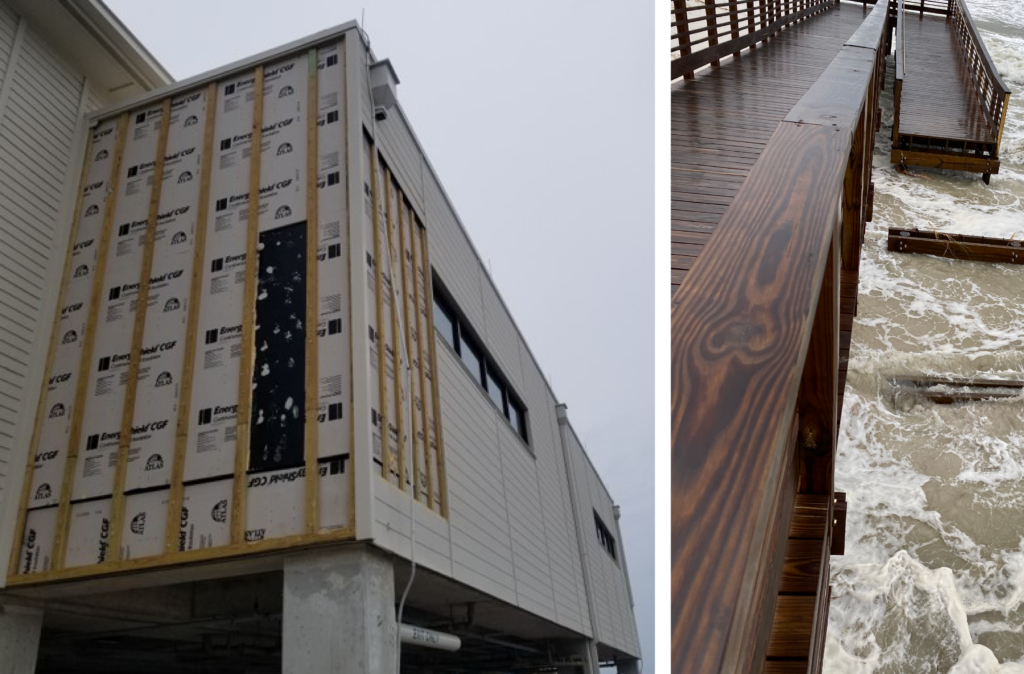
The only damage that the Lodge received was to the machinery on the roof that was not part of the FORTIFIED process, such as the air conditioning units, and siding damage from flying debris. The Lodge’s boardwalks to the Gulf of Mexico also sustained some damage from the storm surge.
“With running generators and no structural damage, we were up the next morning cooking meals for first responders and the community,” says Bennett. “There was so much damage throughout Gulf Shores, and the fact that our operations were uninterrupted is a testament to the FORTIFIED Commercial™ construction process.”
Unfortunately, older park facilities, such as the Shelby Lake cabins, within the park were heavily damaged. The Gulf State Park Pier that was undergoing renovations and scheduled to reopen in late 2020 was also destroyed.
“The cabins, which were built over 40 years ago, sustained significant damage,” says Bennett. “Several lost their roof and had walls collapse.”
The economic impact
When Hurricane Ivan hit in 2004, the original Lodge at Gulf State Park was an economic driver for Alabama’s state park system. It was also an integrated part of the community and a corporate meeting destination.
In 2010, the Deepwater Horizon oil spill further damaged the Gulf Coast tourism industry. Through the Deepwater Horizon settlement, Alabama was awarded $100 million through NRDA in 2014. Of that total, $85.5 million was earmarked for the Gulf State Park Enhancement Project.
Funding the project was an investment in Alabama’s coastal future as the new lodge had a projected economic impact of $68 million per year and a cash flow of approximately $6 million per year. Additionally, the construction and operations of the project brought hundreds of jobs to the area.
Building a resilient structure also had a positive economic impact to job security. When a business is damaged or destroyed during a natural disaster, many employees lose their jobs or are out of work for long period of times.
“By building FORTIFIED facilities, none of our associates lost their job due to closed operations,” says Bennett.
Sustaining the certifications
Building a FORTIFIED CommercialTM roof is only the beginning of IBHS’ certification process. The program includes continual maintenance inspections and a five-year reapplication to stay certified.
“After Sally, IBHS inspected each roof for any vulnerabilities from the storm to verify that it would continue to hold up to future hurricanes,” says Cioffi.
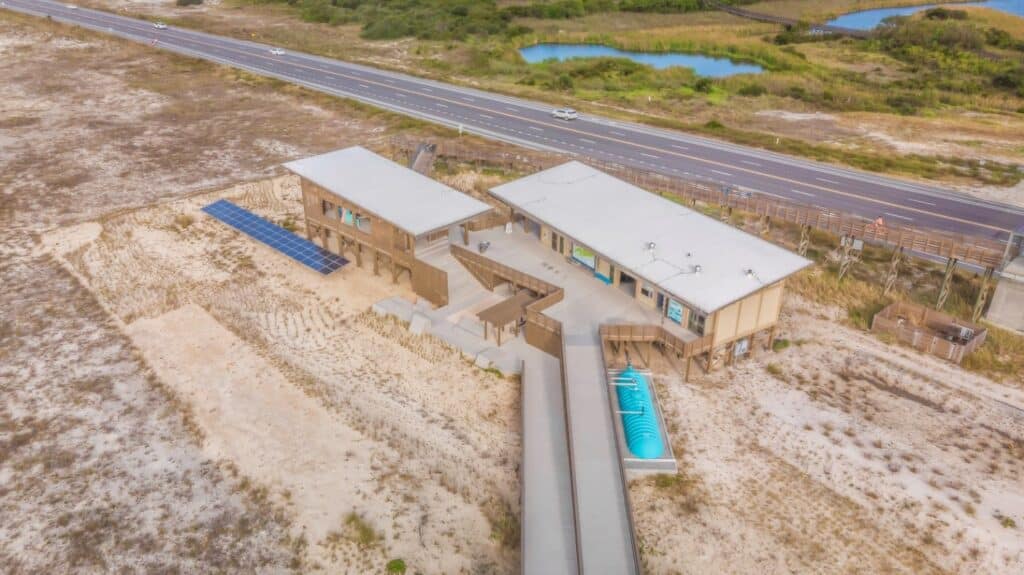
The Lodge at Gulf State Park is also a certified LEED Gold and SITES® Platinum property. The Learning Campus and Woodside Restaurant are also certified LEED Silver and FORTIFIED Commercial. The Interpretive Center, pictured above, is certified LEED Platinum and was the first-ever certified FORTIFIED Commercial building.
“These designations represent the park’s commitment to serving as an international benchmark of environmental and economic sustainability through responsible design and construction,” says Leon Barkan, CCM, Volkert’s chief operating officer and program management practice lead. “These beautiful facilities go beyond basic building code requirements to ensure that it will welcome and educate visitors to Alabama’s Gulf Coast for years to come.”
Volkert’s history at Gulf State Park
For over 50 years, Volkert has been a design and environmental services partner of the Alabama Department of Conservation and Natural Resources (ADCNR) at Gulf State Park. Over the years, Volkert has continued to provide services to the park that enhance its beauty and utility while minimizing impact on its wetland environment.
In addition to serving as the construction manager for this project, Volkert also played an integral part in the dune restoration and environmental permitting. Click here to learn more about the Gulf State Park Enhancement Project and Volkert’s work to preserve and protect the 6,150 acres of pristine coastal scenery on the historic Alabama Gulf Coast.
